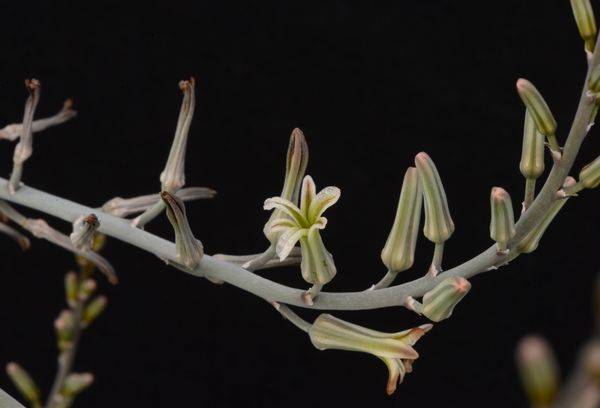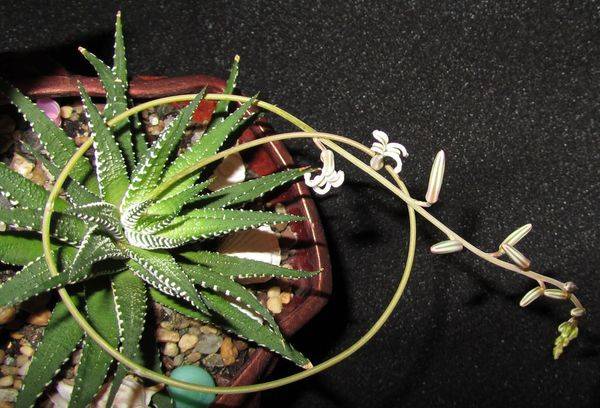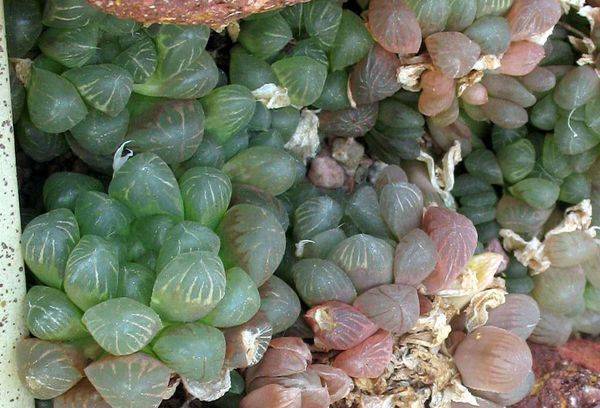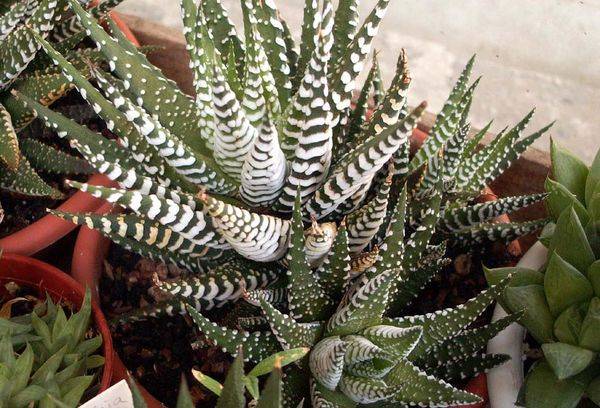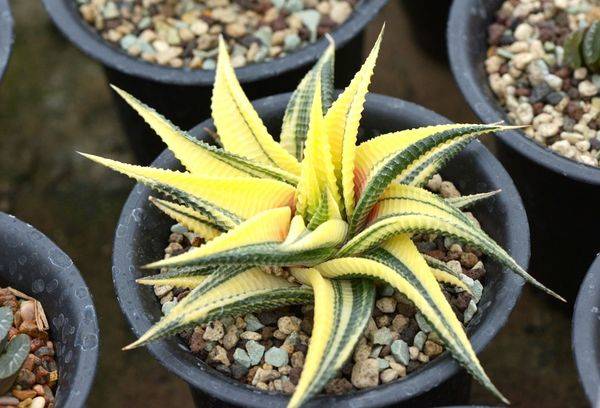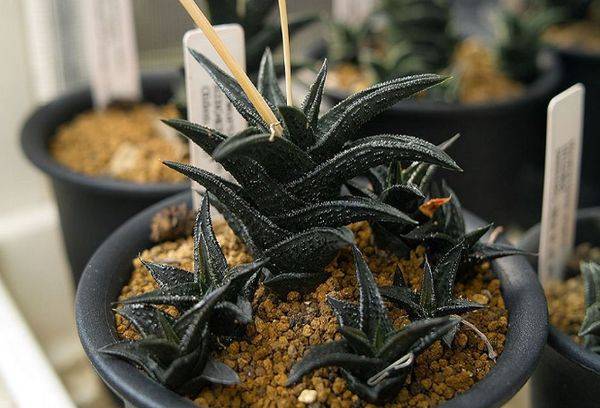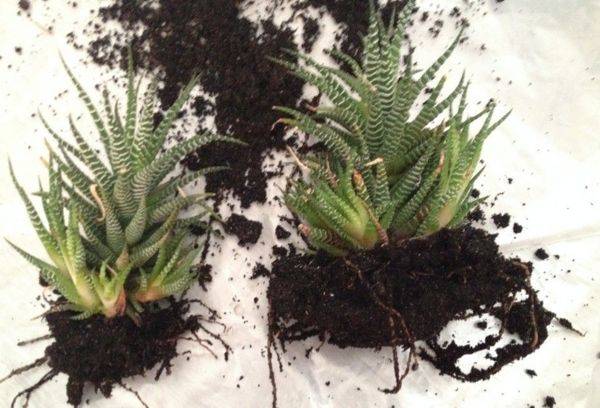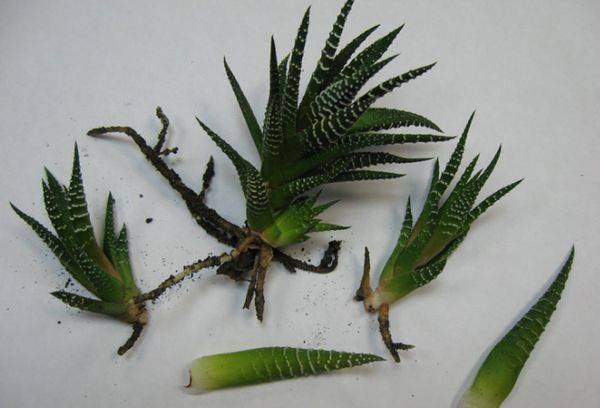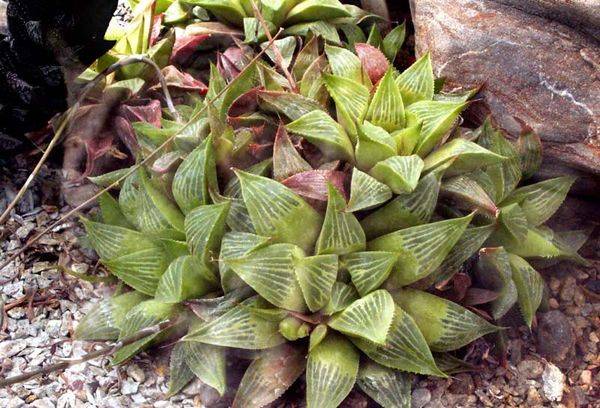How to grow a miniature haworthia flower and provide it with proper care
Content:
The unusual haworthia plant evokes mixed feelings among gardeners: they are attracted by the exotic look of succulents, but they are supposedly scared away by the difficult care of it. But those who tried to grow Haworthia at home came to the opposite conclusion. The plant tolerates indoor conditions well, and it is not at all difficult to care for. If you like cacti and succulents, don't miss the haworthia: it will complement your collection.
Description
Haworthia looks like a miniature aloe or cactus. Its fleshy leaves are collected in neat rosettes and decorated with notches, accumulate moisture (haworthia - succulent). The plant is not cactus, it is a representative of the asphodel family (monocotyledonous flowering plants). Together with their relative aloe, they belong to the asphodel subfamily.
Homeland haworthia - desert of South Africa. Succulents adapted to survive on rocky mounds, sandy soils and among thickets of hard grass. Under natural conditions, grows up to 1 m in height, and at home - no more than 10-15 cm. Flowering haworthia does not differ in beauty. Her flowers are plain and small. All the charm lies in the miniature rosette of leaves.
Haworthia is represented by several species. Some of them have a small stem, but basically a rosette of leaves grows directly above the soil. Haworthia leaves can be covered with a pattern - white convex tubercles. Other differences between species - the shape, rigidity, length and color of the sheet.
Kinds
The genus haworthia is represented by 150 species. In home floriculture, these and other names are used:
- Pearl haworthia (Haworthia margaritifera). The species has fleshy oval leaves, growing 7-8 cm long and 2.5 cm wide. There is practically no stem. Leaflets are strongly pointed from above, their tips are similar to antennae. The edges are covered with white prickly denticles. During the flowering period, you can see a long peduncle (up to 60 cm) and light green racemose inflorescences on it.
- Haworthia Cooperi Miniature Succulent. The rosette is formed by light green leaves covered with long cilia. The length of the whole plant is about 2.5 cm.
- Scaphoid Haworthia (Haworthia cymbiformis). This name is given to the species due to the shape of the leaves. They are bluish-green, about 4-5 cm long, 1-1.2 cm wide. The entire rosette grows with a diameter of 8-10 cm. The leaves are smooth, with almost no growths.
- Haworthia striped (Haworthia fasciata). Dark green elongated leaves of this species are covered with white transverse stripes. A rosette of leaves does not have a stem, grows up to 15 cm in diameter.
- Haworthia limifolia (Haworthia limifolia) looks like a symmetrical star. The base of the sheet is wide, and the tip is narrow. The leaf itself is dark green, covered with golden stripes along its entire length.
Care Rules
How to care for miniature succulents? For all types of haworthias, the care requirements are the same. A plant goes through two periods in a year: growth and dormancy. Following a few rules, even a beginner will grow a pretty succulent on his windowsill. Basic requirements for lighting and heat:
- The light should be bright, but diffused. The best place for succulents is the east or west window.
- There is not enough light on the north window; the plant may fade. If the flowerpot is forcedly located on the south side, then shading is mandatory.
- If the weather is hot, then the haworthy should be taken out into the fresh air, but not exposed to the scorching rays. A balcony or shaded terrace is suitable.
- At any time of the year, the flower needs access to fresh air, so it is recommended to ventilate the room even in winter.
- Haworthia can harm drafts and precipitation.
- The flower loves coolness, but they can easily tolerate heat up to + 45 ° C. The temperature regime from March to October is from +15 to +25 degrees. During the rest period, the room should not be lower than + 5 ° C and not higher than +10. In winter, haworthia should not be near a cold window.
The flowering of haworthia is not such a grandiose event, since its inflorescences do not differ in grace and bright colors. In addition, the South African guest growing in the room rarely blooms.
Tip
Flowering depletes haworthia, the plant may even die. That is why flower growers are advised not to tempt fate and immediately cut the flower stalk.
Watering, humidity and feeding
A flower costs a little water. Water only the topsoil in the flowerpot. In summer, each new watering is done after the soil has dried. Watering conditions in winter:
- at a temperature of +10 to + 12 ° C - once a month;
- if the room temperature reaches 18-20 degrees of heat, then watered twice a month.
Water should be warm, soft, preferably settled. The direction of irrigation is under the plant. If water gets into the outlet, the flower may rot. It is advisable to remove excess water from the sump. Humidity does not matter.
Haworthia will not refuse fertilizers.
Tip
Enter them between April and August, and exclude them in the fall and winter.
One feeding a month is enough. Fertilizers are suitable for cacti and succulents. Proportions - two times less than indicated on the package. Avoid high nitrogen fertilizers.
Transfer
The transplant procedure is needed for young plants annually. Adults are transplanted as necessary, usually no more than once every two to three years. The time for transplanting is spring. Sign that urgent haworthy transplant is required:
- the pot became small (the leaves will become smaller);
- if the roots die off after winter.
The haworthia pot must be shallow and wide. The root system in such a container will not rot from excess moisture. In too deep and large pots, the succulent begins to grow in depth. It is better to grow succulent in a plastic round pot. In a square container, the roots will take on an unnatural shape.
When extracting a plant from an old pot, gently shake off the substrate from the roots. Rotting and dead areas must be cut off and treated with fungicide. Before planting, you need to dry the roots for 24 hours if they are healthy, and 10 days if they had to be treated. When placed in a new pot, the haworthia is covered with a substrate before leafing, but the soil cannot be compacted with palms.
Succulent soil is sold in a flower shop. purityis.decorexpro.com/en/ magazine recommends adding a little clay and small expanded clay to it. These additives will absorb excess moisture well if you flood the haworthia with careless movement. Do not forget to lay the drainage layer on the bottom of the container, it should occupy 1/3 of the flowerpot.
To make the substrate yourself, take in equal amounts:
- clay-soddy soil,
- sheet earth
- sand.
Breeding
There are three ways to reproduce:
- Children: during the transplant, separate the children who have taken root. Drop them in a separate pot. The substrate must be wet. It is allowed to plant a daughter outlet without roots. It will take root in the substrate.
- Leaves. They need to be cut off or broken off from the mother socket. The leaf should dry for two days. Then it is planted in the earth slightly moistened with water. Within a month, the sheet does not need to be watered. During this time, it will take root.
- It is more difficult to propagate haworthia seeds, this method is more suitable for breeders.
Reproduction is best done in the spring during transplantation. The container does not need to be covered with a bag or anything else: in the greenhouse, the flower is likely to rot.
Tip
In the first year of life, it is better to hide young seedlings from the bright sun.So their root system will be stronger.
Growing difficulties, tips
Diseases and pests do not bypass miniature haworthia. What flower growers face when growing succulents:
- scutellum - gray-brown growths on the back of the leaf;
- aphids - pale green insects settle in the lower part of the leaves;
- root worm - the leaves turn red and deformed, the soil is covered with white flakes.
If these pests are found, then all diseased parts of the plant are removed. Slices are processed with charcoal and dried. It does not hurt to apply an insecticide. Also, an emergency transplant of a plant into a healthy soil does not hurt. Old pot and substrate should be discarded.
What threatens improper care (symptoms and the most likely cause):
- The leaves take on a reddish or yellowish hue - you overfed the flower.
- The leaves became limp and blackened - drafts and too low temperatures.
- The shoot is stretched, the rosette of leaves is loose - a shortage of solar energy.
- Another reason for stretching the shoot is a too small pot.
- The tips of the leaves dry out - little moisture, too dry air.
- Blackening of foliage - excess moisture in the soil.
- Brown spots on the leaves - exposure to the sun.
Haworthia is well grown in the florarium. She picks up neighbors with similar care requirements. Haworthia of several species and other succulents coexist well. The composition is composed a little chaotically and is decorated with pebbles, pebbles, colored sand, interesting figures. Florarium with haworthia is an interior decoration that brings a touch of exoticism.
Interesting Haworthia
Some interesting facts about an exotic flower:
- In addition to miniature plants, the plant has another advantage: the life span of an indoor specimen reaches 30 years!
- The name haworthia comes from the name of the English botanist E. Haworth, who determined its place in the classification of plants.
- Popular sign: Haworthia retains positive energy in the home.
This graceful dwarf succulent has already won many hearts. It is your turn to experience the charm of haworthia. Caring for dwarf succulents will not take much time and effort, but you will be proud of the result.

